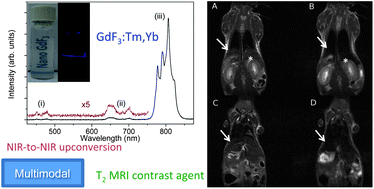PEG-capped, lanthanide doped GdF3nanoparticles: luminescent and T2 contrast agents for optical and MRI multimodal imaging†
Abstract
A facile method for the synthesis of

* Corresponding authors
a
Dipartimento di Biotecnologie, Università di Verona and INSTM, UdR Verona, Strada Le Grazie 15, I-37134 Verona, Italy
E-mail:
adolfo.speghini@univr.it
b Dipartimento di Chimica Molecolare e Nanosistemi, Università Ca' Foscari Venezia and INSTM, UdR Venezia, Via Torino 155/b, Venezia – Mestre, Italy
c Dipartimento di Informatica, Università di Verona and INSTM, UdR Verona, Strada Le Grazie 15, I-37134 Verona, Italy
d Dipartimento di Scienze Neurologiche, Neuropsicologiche, Morfologiche e Motorie, Università di Verona, I-37134 Verona, Italy
e Institut National de la Recherche Scientifique – Énergie, Matériaux et Télécommunications, Université du Québec, Varennes, QC J3X 1S2, Canada
A facile method for the synthesis of

 Please wait while we load your content...
Something went wrong. Try again?
Please wait while we load your content...
Something went wrong. Try again?
T. Passuello, M. Pedroni, F. Piccinelli, S. Polizzi, P. Marzola, S. Tambalo, G. Conti, D. Benati, F. Vetrone, M. Bettinelli and A. Speghini, Nanoscale, 2012, 4, 7682 DOI: 10.1039/C2NR31796F
To request permission to reproduce material from this article, please go to the Copyright Clearance Center request page.
If you are an author contributing to an RSC publication, you do not need to request permission provided correct acknowledgement is given.
If you are the author of this article, you do not need to request permission to reproduce figures and diagrams provided correct acknowledgement is given. If you want to reproduce the whole article in a third-party publication (excluding your thesis/dissertation for which permission is not required) please go to the Copyright Clearance Center request page.
Read more about how to correctly acknowledge RSC content.
 Fetching data from CrossRef.
Fetching data from CrossRef.
This may take some time to load.
Loading related content
